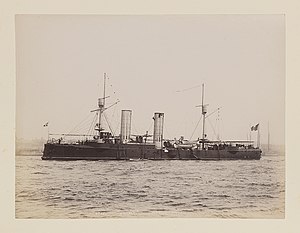| Dogali Montevideo | ||
|---|---|---|
 El crucero Dogali | ||
| Banderas | ||
|
| ||
| Historial | ||
| Astillero | Armstrong Whitworth (Reino Unido) | |
| Tipo | Crucero protegido | |
| Operador | Regia Marina | |
| Botado | 1885 | |
| Asignado |
| |
| Baja |
| |
| Destino |
| |
| Características generales | ||
| Desplazamiento | 2.088 t | |
| Eslora | 76,2 m | |
| Manga | 11,3 m | |
| Calado | 4,4 m | |
| Armamento |
4 x 152 mm 9 x 57 mm 2 x 37 mm 4 torpedos x 356 mm | |
| Propulsión |
2 hélices Triple expansión 4 calderas | |
| Potencia | 5.012 CV de potencia | |
| Velocidad | 19,7 nudos | |
| Autonomía | 4.000 millas náuticas a 10 nudos | |
| Tripulación | 224 | |
El Dogali fue un crucero protegido italiano, el primero en poseer máquinas de triple expansión. En 1908 fue vendido a la Armada de Uruguay y rebautizado como Montevideo.
Historial

Se comenzó su construcción para la Armada de Grecia como Salamis[1], pero acabó siendo el crucero de combate italiano Dogali[2], aunque en un principio iba a llamarse Angelo Emo. Cuando se finalizó su construcción aparejaba velas áuricas, pero estas se dejaron de usar en 1890. Los cañones de 152 mm estaban situados en la proa, cubierto con un casamata en forma de caparazón, y en popa.[1] Los otros dos, en las amuras de babor y estribor. Fue copia del crucero británico Elswick, aunque era de construcción más ligera.[1]
En 1908 fue vendido a Uruguay; fue rebautizado inicialmente como 25 de Agosto y en 1910 se le cambió el nombre a Montevideo. Fue dado de baja en 1914 (estuvo amarrado sin salir del puerto) y se retiró completamente de servicio total en 1924, aunque fue conservado hasta su desguace en 1932.[3] El Dogali combinó la alta velocidad, buena protección y un poderoso armamento.
Bitácora
- 1904 - Remontó 4.250 millas del Río Amazonas.
Referencias
- ↑ a b c Fraccaroli,, p. 349.
- ↑ Beehler,, pp. 164–167.
- ↑ Gardiner & Gray,, p. 425.
Bibliografía
- Beehler, W. H. (1887). «Naval Manoevres, 1887: Italian». Information from Abroad (Washington, D.C.: Government Printing Office): 164-167. OCLC 12922775.
- Brassey, Thomas A., ed. (1888). «Developments of the Year». The Naval Annual (Portsmouth: J. Griffin & Co.): 728-731. OCLC 5973332.
- Fraccaroli, Aldo (1979). «Italy». En Gardiner, Robert, ed. Conway's All the World's Fighting Ships 1860–1905. London: Conway Maritime Press. pp. 334-359. ISBN 978-0-85177-133-5. (requiere registro).
- Friedman, Norman (2011). Naval Weapons of World War One. Annapolis: Naval Institute Press. ISBN 978-1-84832-100-7.
- Garbett, H., ed. (1894). «Naval and Military Notes». Journal of the Royal United Service Institution (London: J. J. Keliher) XXXVIII: 193-206. OCLC 8007941.
- Garbett, H., ed. (June 1897). «Naval Notes—Italy». Journal of the Royal United Service Institution XLI (232): 788-790. OCLC 8007941.
- Garbett, H., ed. (1903). «Naval Notes». Journal of the Royal United Service Institution (London: J. J. Keliher & Co.) XLVII (307): 1058-1075. OCLC 8007941.
- Gardiner, Robert; Gray, Randal, eds. (1985). Conway's All the World's Fighting Ships 1906–1921. Annapolis: Naval Institute Press. ISBN 0-87021-907-3.
- Marley, David (2008). Wars of the Americas: A Chronology of Armed Conflict in the Western Hemisphere, 1492 to the Present. Santa Barbara: ABC-CLIO. ISBN 978-1-59884-100-8.
- Neal, William George, ed. (1899). «The International Naval Review at New York and the Opening of the Chicago Exposition». The Marine Architect (London: Office for Advertisements and Publication) XV: 97-101. OCLC 2448426.
- «Pensacola Navy-Yard». Annual Reports of the Navy Department: For the Year 1905 (Washington, DC: Government Printing Office): 726-727. 1906. OCLC 5164555.
- Robinson, Charles N., ed. (1897). «The Fleets of the Powers in the Mediterranean». The Navy and Army Illustrated (London: Hudson & Kearnes) III: 186-187. OCLC 7489254.
- «The Chronicle». The Messenger (New York) XLVII: 526-544. 1907.








